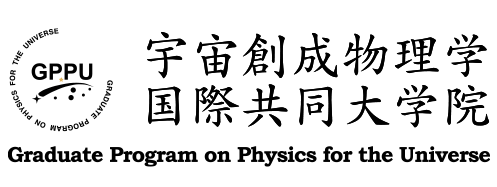GPPU Seminar
1) Neutron distribution of 208Pb by low-energy electron scattering
2) The GroundBIRD experiment for verifying the optical depth tau to the reionization epoch
1) Rika Danjo; 2) Miku Tsujii
(Tohoku University)
Date
10:00-12:00, February 15th, 2024Place
(hybrid) Room 743, Science Complex B (H-03), Zoom registration mapAbstract
1) The charge density distributions of nuclei are best determined by elastic electron scattering, and the stable nuclei that have been studied so far have played an essential role in revealing their internal structure. Recently, it was pointed out theoretically that the 4th moment of the charge density distribution,
Reference
[1] H. Kurasawa and T. Suzuki, “The nth-order moment of the nuclear charge density and contribution from the neutrons”, Prog. Theor. Exp. Phys. 2019, 113D01(2019).
[2] H. Kurasawa, T. Suda and T. Suzuki, ”The mean square radius of the neutron distribution and the skin thickness derived from electron scattering”, Prog. Theor. Exp. Phys. 2021, 013D02(2021).
2) GroundBIRD is a ground-based Cosmic Microwave Background (CMB) experiment for observing the polarization pattern imprinted on large angular scales (6 < l < 300) at the Teide Observatory in Tenerife, Spain. One of our primary scientific objectives is precisely measuring the optical depth tau (sigma(τau) ~ 0.01) to the reionization epoch of the Universe after the Planck satellite for the first time. GroundBIRD observes a large sky region (~45% of full-sky) while continuously rotating the telescope at a high speed of 20 rotation-per-minute to overcome the fluctuations of atmospheric radiation. We have adopted the NbTiN/Al hybrid type Microwave Kinetic Inductance Detector (MKID) as detectors. It achieves a noise level that is sufficiently lower than that due to the optical loading at the observation site and the time response is fast enough for GroundBIRD’s rotation.
We observe two frequency bands (145 GHz and 220 GHz) to suppress contamination of thermal radiation emitted by astronomical dust particles. These features enable us to observe the reionization bump in the E-mode power spectrum of CMB polarization appeared in low l, which corresponds to a large angular scale, and to measure the optical depth tau. The MKID arrays (138 MKIDs for 145GHz and 23 MKIDs for 220GHz), which were designed by Tohoku University and TU Delft and were fabricated by TU Delft/SRON, were installed in May 2023 after the performance verification test performed at the laboratory. In this presentation, we report the remote observation system and initial results of on-site performance.
Point
GSP 1Contact: Yusuke Tanimura (tanimura [at] nucl.phys.tohoku.ac.jp)
